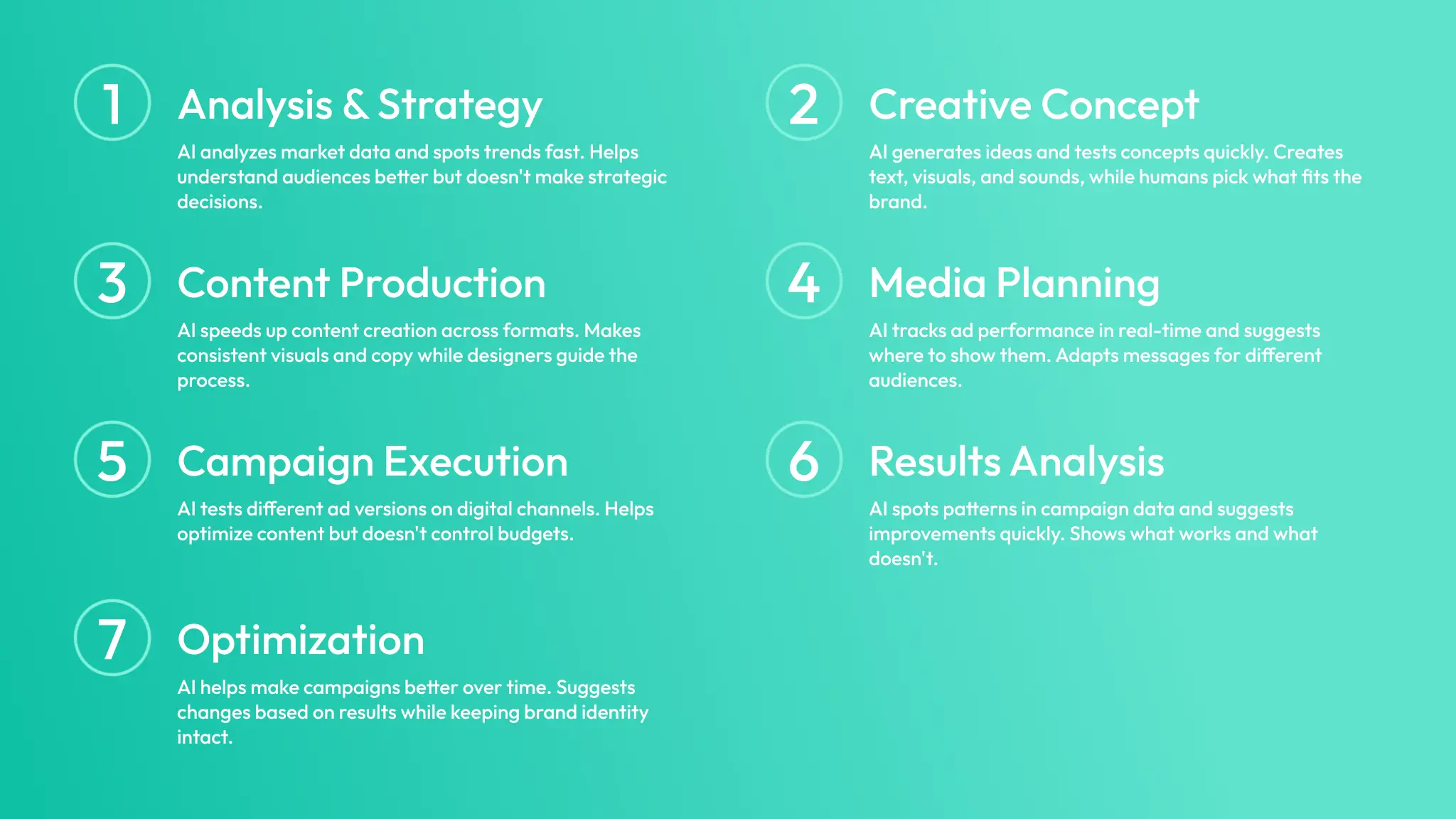Artificial Intelligence in marketing isn't just a fancy tool anymore - it's now essential. Brands use it to analyze data, improve campaigns, create content, and automate production. The real question isn't if you should use AI, but where it helps most.
The Evolution of AI in Marketing Campaigns
AI doesn't change the basic steps of ad campaigns - from planning to creating to improving. But it changes how we do each step. Let me show you how, using examples from Coca-Cola, Komfort, Orlen, and our Content AI Creator platform.

1. Analysis and Strategy
Ad campaigns start with knowing your market, competition, and audience. AI helps by quickly looking at data, finding trends, and grouping audiences. But remember - AI helps you make decisions, it doesn't make them for you.
Look at Coca-Cola's holiday ads. They always use red trucks, snow, and that special music. They didn't use AI to pick these ideas. Instead, they used AI to make and test new versions of ads with these elements. This shows how to use AI smartly - let it improve your work while you keep control of your brand's big picture.
2. Creative Concept
AI can write text, check what words work best, and suggest visual ideas. But humans still lead the creative process. AI helps test ideas and create content faster.
Take the Komfort Black Sales campaign. AI wrote song lyrics, made music, and created animations. But our creative team picked the best parts and shaped them to fit the brand. This shows how AI speeds up creative work while humans guide the vision.
3. Content Production
AI makes creating content faster and cheaper. Look at Orlen's StopCafe campaign. We used AI to make visuals for both digital and outdoor ads. This let us create consistent ads in many sizes and formats quickly.
But AI doesn't work alone. In Orlen's case, it helped our designers work better - it didn't replace them.
4. Media Planning and Buying
AI helps plan where to show your ads. It watches how ads perform in real time and moves money to what works best. It can also change messages for different groups of people based on how they react.
But watch out - AI often focuses on quick results. You need to balance this with your long-term brand goals.
5. Campaign Execution
AI helps improve ads while they run, especially online. It tests different versions of ads in programmatic, social media, and display campaigns.
In the Komfort Satisfaction campaign, AI helped make animations and sounds. But the media house decided where to show the ads - we didn't let AI control the budget. Same with Coca-Cola - AI helped make content, but they kept traditional ad placement.
6. Results Analysis
AI is great at looking at past data and suggesting improvements. It can quickly show patterns and make suggestions. But when it lacks data, it can't predict what will happen next. That's why we need marketing experts to make sense of the data and connect it to your strategy.
7. Optimization
AI changes how we run ad campaigns, but humans still make the key decisions. Smart brands combine AI with creativity and long-term thinking. The trick is finding the right balance between automation and unique messages.
Be careful - if you use AI just to make things faster, you might lose control of your message. Your ads could start looking like everyone else's.
The winners will be brands that adapt AI to fit their own goals and values, not those who just follow the crowd.
Consider strategic approach
For Marketing Directors considering AI implementation, success lies in finding the right balance between automation and uniqueness in communication. Organizations that treat AI merely as a process optimization tool risk losing control over their message, potentially resulting in homogeneous and predictable campaigns.
The mimo.ooo approach, centered on personalization, demonstrates how AI can be effectively integrated into marketing operations. We use on a daily basis this 7-Stage Framework for AI-Powered Marketing Campaign Management and we’ve built a tool on top of that. Content AI Creator (CAC) utilizes four specialized models:
- CORE: Strategy analysis, insights, and conceptual content
- VISION: Visualizations, key visuals, and video
- ECHO: Narrative, sound, and audio tracks
- PULSE: Results analysis and optimization recommendations
.webp)
It helps to adapt AI to brand unique objectives and values, rather than following generic, mass-market solutions. It ensures a strategic approach to AI implementation that:
- Maintains brand consistency while leveraging automation
- Balances short-term optimization with long-term brand building
- Integrates AI capabilities across all campaign stages
- Ensures human oversight of strategic decisions
- Customizes AI implementation to specific brand needs
Conclusion
AI in marketing communications is a powerful tool that can increase effectiveness, streamline processes, and deliver personalized content. However, its success depends on thoughtful implementation and integration with brand objectives. There's no one-size-fits-all solution—each brand has unique needs and challenges, making it crucial to adapt AI tools to individual requirements.The key to success lies in viewing AI not as a replacement for human creativity and strategic thinking, but as an enabler that allows marketing teams to focus on higher-value activities while automating routine tasks. This approach ensures that AI enhances rather than diminishes the unique value proposition of your brand.















.svg)




